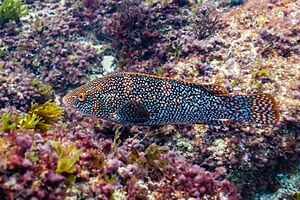Ballan wrasse facts for kids
Quick facts for kids Ballan wrasse |
|
|---|---|
 |
|
| Conservation status | |
| Scientific classification | |
| Synonyms | |
|
The ballan wrasse (Labrus bergylta) is a type of fish that lives in the ocean. It belongs to the wrasse family. You can find these fish in the eastern Atlantic Ocean, especially in rocky areas.
One cool thing about ballan wrasse is that they are protogynous hermaphrodites. This means all young fish start out as females. Later, some of the bigger, more dominant females change into males. People sometimes eat ballan wrasse. They are also used to help keep Atlantic salmon farms clean in Europe.
Contents
What Does the Ballan Wrasse Look Like?
The ballan wrasse is a big, strong fish. It has a deep body and a large head. Its mouth is quite small, but it has thick, wrinkled lips. Inside its mouth, it has a single row of strong teeth. Young wrasse have sharp teeth, but older ones have blunter, more worn teeth.
This fish has a long top fin called a dorsal fin. It also has a shorter fin underneath, called the anal fin. Its body is covered in large scales.
Young ballan wrasse are often green, matching their rocky, seaweed-filled homes. They can be light green or even bright emerald green. Adult wrasse have more varied colors. They can be dark green or reddish-brown. They are covered in many small white spots.
Ballan wrasse can grow up to about 65 centimeters (26 inches) long. Most are around 50 centimeters (20 inches). The heaviest one ever recorded weighed about 4.4 kilograms (9.7 pounds).
These fish mostly swim using their side fins, called pectoral fins. They can swim quickly in short bursts, but they don't swim fast for long periods.
Where Do Ballan Wrasse Live?
Ballan wrasse live in the northeastern Atlantic Ocean. You can find them from Norway all the way down to Morocco. They also live around islands like Madeira, the Azores, and the Canary Islands. There have been reports of them in the Mediterranean Sea. However, these might be other types of wrasse that look similar.
Habitat and Life Cycle
Ballan wrasse live in water that is 1 to 50 meters (3 to 164 feet) deep. They like places with rocks, seaweed, and reefs.
As mentioned, all ballan wrasse start as females. They stay female for 4 to 14 years. After that, some of the larger females change into males. Almost all very large ballan wrasse are males.
Their thick lips and strong front teeth help them pull shellfish off rocks. They also have powerful teeth deeper in their throat. These teeth can crush shells to get to the soft meat inside. Ballan wrasse also eat crustaceans, like hard-shelled crabs and small lobsters. They often swim into shallower water to find shellfish clinging to underwater cliffs. They also like to live in areas with lots of kelp and other seaweeds.
When it's time to reproduce, the male wrasse builds a nest. He uses algae and hides the nest in a rocky crevice. One or more females will lay their eggs in this nest. The male then guards the eggs until they hatch. The eggs hatch into tiny larvae after about one or two weeks.
Did you know? Ballan wrasse do not have stomachs!
How Do Humans Use Ballan Wrasse?
Fishing and Sport
Ballan wrasse are eaten in some places, like the Orkney Islands in Scotland and Galway in Ireland. However, they are not a popular food fish in most of the UK and Ireland.
In recent years, they have become popular with sport fishermen. People enjoy catching them using light fishing tackle and then releasing them. This is called "catch-and-release" fishing.
Aquaculture
Ballan wrasse are very important in fish farming. They are one of five main types of "cleaner fish." These fish are used to remove tiny parasites called sea lice from farmed salmon. In 2020, over 3 million ballan wrasse were used in salmon farms in Norway alone.
Because so many wild wrasse were being caught for this purpose, people started farming them. This helps protect the wild populations. When young wrasse are farmed, they are first fed tiny live creatures. Later, they are switched to dry food once they grow bigger.
You can also find ballan wrasse in the aquarium trade.


